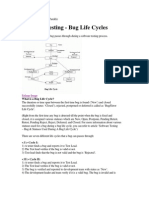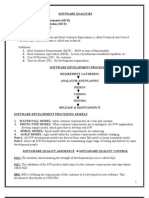(Project Name) Test Plan: (Document Version Number) Project Team: (Date)
(Project Name) Test Plan: (Document Version Number) Project Team: (Date)
Uploaded by
Tanisha MitchellCopyright:
Available Formats
(Project Name) Test Plan: (Document Version Number) Project Team: (Date)
(Project Name) Test Plan: (Document Version Number) Project Team: (Date)
Uploaded by
Tanisha MitchellOriginal Title
Copyright
Available Formats
Share this document
Did you find this document useful?
Is this content inappropriate?
Copyright:
Available Formats
(Project Name) Test Plan: (Document Version Number) Project Team: (Date)
(Project Name) Test Plan: (Document Version Number) Project Team: (Date)
Uploaded by
Tanisha MitchellCopyright:
Available Formats
[Project Name] Test Plan
[Document Version Number]
[Date]
Project Team:
[Name] [Role]
[Name] [Role]
[Name] [Role]
[Name] [Role]
[Name] [Role]
Document Author(s):
[Name]
Project Sponsor:
[Name]
I. Introduction
This serves as the plan for testing all software artifacts as well as the reporting of test results.
II. Test Plan
Use the template below to specify the black box test cases you will run on your code. Every requirement must have
a minimum of one test case. Considering equivalence class partitioning, boundary value analysis, and
diabolical test cases, it is likely that each requirement should have several test cases.
Test ID
Description
Expected Results
Actual Results
Where:
Test ID is a unique identifier for the test case. The unique identifier should relate back to the
particular requirement the test case is verifying. For example, if your naming scheme for
requirements is numbers, test cases for requirement 3 could have test IDs 3.1, 3.2, etc. Acceptance
test cases must end the Test ID with a *.
Description should clearly document the steps that need to be done in order to run the test case.
Write the description specifically, such that any team member can run the test case, even if the
author of the test case is not present.
Expected results is a statement of what should happen when the test case is run.
Actual results are an indication of whether the test case is currently passing or failing when it is
run. The actual results could be recorded simply as Pass or Fail. However, it is also helpful
to describe what happened in cases where a test case fails.
Ultimately, your customer should agree to the test case. When test cases are written so specifically, often
requirements understanding is enhanced.
III. Testing Deliverables
Specify the planned testing deliverables which may include:
Test Design Specification
Test Case Specification
Test Procedure Specification
Test Log
Test Incident Report
Test Summary Report
Test Input and Output Data
IV. Environmental Requirements
Specify the environmental needs for conducting tests:
Hardware, communications and system software, other supplies, etc.
Level of security
Testing tools
V. Staffing
Specify testing responsibilities, staffing and training needs.
VI. Schedule
Specify testing schedule.
VII. Risks and Contingencies
Specify any potential risks and plans for mitigating, addressing and/or resolving those risks.
VIII. Approvals
List any approvals / signatures required to sign off on test results.
IX. Document Revision History:
Version
Name(s)
Date
Change Description
File version number.
Name of individual(s) responsible for the change.
Date of change.
Description of the changes made to the file.
You might also like
- Black Box Testing DocumentDocument15 pagesBlack Box Testing DocumentSimran Radheshyam Soni100% (1)
- 7492 - Agile Test Summary Report TemplateDocument9 pages7492 - Agile Test Summary Report TemplateDaniel JosiahNo ratings yet
- Practice Use CaseDocument3 pagesPractice Use Caseananduthaman100% (1)
- Defect Life CycleDocument3 pagesDefect Life CycleSharanappa Rathod100% (1)
- Software Engineering SW ProcessDocument43 pagesSoftware Engineering SW ProcessblinNo ratings yet
- AWS+Tagging Naming+ConventionsDocument4 pagesAWS+Tagging Naming+ConventionsJason GonzalesNo ratings yet
- Mass Deployment of SAP Solution Manager Diagnostics Agent With NW2007 SR3 SAP Installer.Document8 pagesMass Deployment of SAP Solution Manager Diagnostics Agent With NW2007 SR3 SAP Installer.walsemgeNo ratings yet
- Lesson 3 - The FutureDocument20 pagesLesson 3 - The FutureDiane JohnsNo ratings yet
- MM01 - Test CaseDocument2 pagesMM01 - Test CaseRadha YedurlaNo ratings yet
- Test Case TemplateDocument9 pagesTest Case TemplateFajar AkhtarNo ratings yet
- Testing Notes 26 - 03 - 2020Document38 pagesTesting Notes 26 - 03 - 2020Abhishek ShrivastavaNo ratings yet
- The Application Lifecycle ManagementDocument7 pagesThe Application Lifecycle ManagementvibhaskelkNo ratings yet
- Manual TestingDocument34 pagesManual Testingbnjee04No ratings yet
- Lab Manual DSP Lab 5 SemDocument46 pagesLab Manual DSP Lab 5 SemQuentin GuerraNo ratings yet
- Unit Testing With JUnit and EasyMockDocument23 pagesUnit Testing With JUnit and EasyMockRajat DhallorNo ratings yet
- Test Case Point EstimationDocument20 pagesTest Case Point EstimationpingdeeptiNo ratings yet
- Project DocumentationDocument56 pagesProject DocumentationDeepika KindraNo ratings yet
- Informatica Naming Standards V2 0Document8 pagesInformatica Naming Standards V2 0kodandaNo ratings yet
- Generating Test CasesDocument11 pagesGenerating Test Casesm_ammarwaheed5570No ratings yet
- Dmart Test ScenarioDocument12 pagesDmart Test Scenarioravi KumarNo ratings yet
- Functional Test Plan For Cluster Management System: Nilesh Manandhar Prasad Aradyula Krishna Chaitanya InturiDocument9 pagesFunctional Test Plan For Cluster Management System: Nilesh Manandhar Prasad Aradyula Krishna Chaitanya InturiChaithra SNo ratings yet
- (Name of Project) : Test StrategyDocument9 pages(Name of Project) : Test Strategyvivek pawarNo ratings yet
- Designing Unit Test Cases PDFDocument15 pagesDesigning Unit Test Cases PDFAndreea DimacheNo ratings yet
- Software Quality Testing Types, ActivitiesDocument21 pagesSoftware Quality Testing Types, ActivitiesJAgreetiiNo ratings yet
- RDBMSDocument197 pagesRDBMSSri SrinikethNo ratings yet
- Green Lantern Automation Framework For Testcomplete: GuideDocument13 pagesGreen Lantern Automation Framework For Testcomplete: GuideNk RhNo ratings yet
- Test Framework For Air CanadaDocument14 pagesTest Framework For Air CanadaSumit JagotaNo ratings yet
- Automation-Selenium Test Automation FrameworkDocument47 pagesAutomation-Selenium Test Automation FrameworkAlok SinghNo ratings yet
- Test Cases Writing: Isuru KodithuwakkuDocument9 pagesTest Cases Writing: Isuru KodithuwakkuIsuru KodiNo ratings yet
- Delphix WP TDM Survival ChecklistDocument3 pagesDelphix WP TDM Survival ChecklistatilabayatNo ratings yet
- Testing4Softwarequ Ality: ManualDocument1 pageTesting4Softwarequ Ality: ManualravikanthNo ratings yet
- Performance Testing Checklist PDFDocument3 pagesPerformance Testing Checklist PDFsrujanNo ratings yet
- SETLabs Briefings Software ValidationDocument75 pagesSETLabs Briefings Software ValidationaustinfruNo ratings yet
- 2 3Document44 pages2 3Mohammad Seemab AslamNo ratings yet
- Defect Tracking FlowchartDocument5 pagesDefect Tracking FlowchartJohn MrGrimm DobsonNo ratings yet
- Design Implementation and Optimization QuartusDocument321 pagesDesign Implementation and Optimization QuartusphithucNo ratings yet
- Performance Testing Presentation On 03julyDocument36 pagesPerformance Testing Presentation On 03julySreenivasulu Reddy SanamNo ratings yet
- Developing A Test Plan For Automated Ticket Issuing System For Dhaka Subway Systems PDFDocument14 pagesDeveloping A Test Plan For Automated Ticket Issuing System For Dhaka Subway Systems PDFRash Styles100% (2)
- Project Name Test PlanDocument21 pagesProject Name Test PlanSunilkumar KotturuNo ratings yet
- CDC Test Case TemplateDocument7 pagesCDC Test Case TemplateanilprasadalluNo ratings yet
- Test Case WrittingDocument7 pagesTest Case WrittingSabari NathanNo ratings yet
- TimeAnalyzer PDFDocument7 pagesTimeAnalyzer PDFPeregrino SantiagueroNo ratings yet
- Srs Template IeeeDocument6 pagesSrs Template IeeeAshishNo ratings yet
- SNO Phase Input: 1 Test Planning What To Test How To Test When To TestDocument2 pagesSNO Phase Input: 1 Test Planning What To Test How To Test When To TestPAVANONLINETRAININGS.COMNo ratings yet
- Junit FundamentalsDocument27 pagesJunit FundamentalsrguptamtechNo ratings yet
- Performance and Load TestingDocument106 pagesPerformance and Load TestingNguyễn ĐôngNo ratings yet
- Function Points or Use Case PointsDocument2 pagesFunction Points or Use Case Pointsmauricioaguiar53No ratings yet
- Agile Artifact ReviewDocument2 pagesAgile Artifact ReviewTony DavisNo ratings yet
- Best Practices Naming StandardsDocument4 pagesBest Practices Naming StandardsSaranya PandiarajNo ratings yet
- JmeterDocument21 pagesJmetervenkatd24No ratings yet
- AWS Strengths: Co MpeteDocument6 pagesAWS Strengths: Co MpeteSalman AslamNo ratings yet
- System Requirements Customer Name: Directions For Using TemplateDocument6 pagesSystem Requirements Customer Name: Directions For Using TemplatesemiariNo ratings yet
- Application Testing 2.1 - UpdatedDocument444 pagesApplication Testing 2.1 - UpdatedPrateek AgnihotriNo ratings yet
- NFR - CHECKLIST - ReviewDocument4 pagesNFR - CHECKLIST - ReviewVarun Vikram SinghNo ratings yet
- Software Requirements Specification: VersionDocument13 pagesSoftware Requirements Specification: Versionsachinsonu15No ratings yet
- OrangeHRM - Test PlanDocument6 pagesOrangeHRM - Test PlanKarthik SudhakarNo ratings yet
- Software Testing e ContentDocument323 pagesSoftware Testing e ContentcelineNo ratings yet
- Software Development Process Models A Complete Guide - 2020 EditionFrom EverandSoftware Development Process Models A Complete Guide - 2020 EditionNo ratings yet
- Unit 6 Assignment 1 - Word TemplateDocument13 pagesUnit 6 Assignment 1 - Word Template20454787No ratings yet
- DELTA IA-ASDA ASDA-SeriesDocument274 pagesDELTA IA-ASDA ASDA-SeriesDavid MartinNo ratings yet
- ATV312HU15N4: Product Data SheetDocument4 pagesATV312HU15N4: Product Data SheetAndres OrozcoNo ratings yet
- Chapter 4: Routing ConceptsDocument66 pagesChapter 4: Routing ConceptsDiane GutierrezNo ratings yet
- UuprogDocument59 pagesUuprogTDCSoft100% (1)
- Shindengen: General Purpose RectifiersDocument5 pagesShindengen: General Purpose RectifiersMuresan SanduNo ratings yet
- Manual SDM230 ModbusDocument13 pagesManual SDM230 ModbusbrahimNo ratings yet
- SeeGull IBflex Hardware Reference Manual Rev MDocument4 pagesSeeGull IBflex Hardware Reference Manual Rev M4jan1980No ratings yet
- ADESystem Jeep SecurityDocument20 pagesADESystem Jeep SecuritycrankyhoboNo ratings yet
- AML Detection Scenarios Transaction Monitoring Sample TemplateDocument10 pagesAML Detection Scenarios Transaction Monitoring Sample Templatepooja kumariNo ratings yet
- Aptitude Made SimpleDocument294 pagesAptitude Made SimpleGopiNo ratings yet
- Assignment - User AuthenticationDocument4 pagesAssignment - User Authenticationtranlehuuphuoc22502No ratings yet
- Ortec Leo The Ideal Solution For Load and Planning Optimization in SAP ERPDocument10 pagesOrtec Leo The Ideal Solution For Load and Planning Optimization in SAP ERPhalwanvNo ratings yet
- 3 Hours / 70 Marks: Seat NoDocument4 pages3 Hours / 70 Marks: Seat NoKrishnaNo ratings yet
- N-Series NetApp Net Apps Drive Part NumbersDocument3 pagesN-Series NetApp Net Apps Drive Part NumbersrejnanNo ratings yet
- I. Read The Questions Carefully. Write The Letter of The Correct Answer On The Space Provided For Before Each NumberDocument2 pagesI. Read The Questions Carefully. Write The Letter of The Correct Answer On The Space Provided For Before Each NumberCarlo Ballon100% (1)
- File Handling: Count For His:2 Count For Her:1Document5 pagesFile Handling: Count For His:2 Count For Her:1Jay MandalNo ratings yet
- Danzas Españolas No. 2, Oriental: AndanteDocument4 pagesDanzas Españolas No. 2, Oriental: AndantefilipeNo ratings yet
- STP DecimalsDocument1 pageSTP DecimalsTinDelaCruzNo ratings yet
- Construct 3 ManualDocument1,379 pagesConstruct 3 ManualLo RainNo ratings yet
- Sie Is DG PG 555 EtuDocument4 pagesSie Is DG PG 555 EtuRuboto BotoNo ratings yet
- FW3020 19.0v1 Getting Started With IPsec Site-To-Site VPNs On Sophos FirewallDocument20 pagesFW3020 19.0v1 Getting Started With IPsec Site-To-Site VPNs On Sophos FirewallAndré MouraNo ratings yet
- s7220b inDocument74 pagess7220b inAndry WayNo ratings yet
- Mi11X - One PagerDocument25 pagesMi11X - One PagerSantosh MetraniNo ratings yet
- Class 11 - Maintenance Planning and Scheduling - DR - AdelDocument30 pagesClass 11 - Maintenance Planning and Scheduling - DR - AdelRajmchz100% (1)
- PQRS Product and Environmental Specifications 230911Document22 pagesPQRS Product and Environmental Specifications 230911Luis HuanqqueNo ratings yet
- Motor Actuator (PSL) - ManualDocument23 pagesMotor Actuator (PSL) - ManualFlo MarineNo ratings yet
- Employee Payroll SystemDocument7 pagesEmployee Payroll Systemsteph_ekeh75% (4)
- ArrayDocument3 pagesArrayRachana Reddy SunkiNo ratings yet

























































































